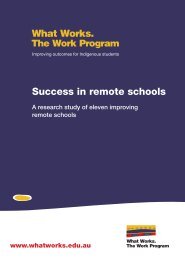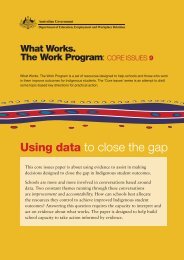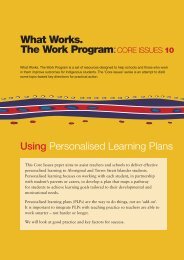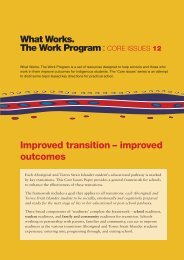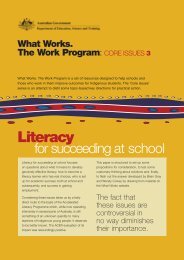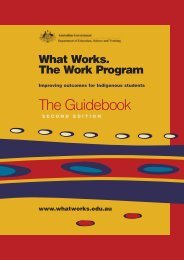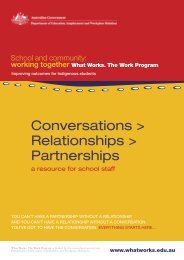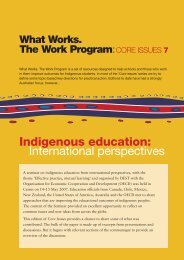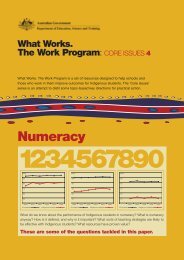THE ARTSCreating art works using skills, techniques, processes <strong>and</strong> technologiesConcept In Year 1 In Year 2 In Year 3 In Year 4 In Year 5 In Year 6 In Year 7 In Year 8 In Year 9CreateStudents select,arrange <strong>and</strong>manipulate elements<strong>for</strong> a purposeStudents use simple <strong>and</strong>familiar, everydaymaterials, instruments <strong>and</strong>tools when pretending,imagining <strong>and</strong> inventingthrough experimentingwith art elements.Students use simple <strong>and</strong>familiar, everydaymaterials, instruments <strong>and</strong>tools, gradually extendingtheir repertoire <strong>and</strong>becoming more familiarwith these by working <strong>for</strong>more sustained periods oftime.Students identify <strong>and</strong> use arange of simple artsprocesses, appropriatetechnologies, skills <strong>and</strong> artslanguages to engage in artsactivities with others.Students make independentchoices from a range offamiliar <strong>and</strong> unfamiliaravailable tools, instruments<strong>and</strong> materials to create artworks <strong>for</strong> their ownsatisfaction.Students apply a range ofspecific skills, techniques,processes <strong>and</strong> appropriatetechnologies, demonstratingan underst<strong>and</strong>ing of artsconventions <strong>and</strong> structures<strong>and</strong> working at prescribedactivities <strong>for</strong> identifiedaudiences or purposes.Students draw on anextensive repertoire of artstechniques, skills <strong>and</strong>processes from a range ofart <strong>for</strong>ms, <strong>for</strong>mats <strong>and</strong>styles to design <strong>and</strong>complete a work of art.Students select from arange of skills, techniques<strong>and</strong> processes, <strong>and</strong>appropriate technologies,organising <strong>and</strong>manipulating elements tocomplete tasks of aspecified <strong>for</strong>m, <strong>for</strong>mat orstyle.Students independentlycombine arts skills,techniques, technologies,<strong>and</strong> processes to create <strong>and</strong>share art works.Students develop a personalaesthetic by drawing on arange of <strong>for</strong>ms, <strong>for</strong>mats <strong>and</strong>styles to create art works<strong>and</strong> explain <strong>and</strong> describetheir style usingappropriate terminology.In Visual Arts thestudent might, <strong>for</strong>example…In Drama the studentmight, <strong>for</strong> example…In Dance the studentmight, <strong>for</strong> example…In Media the studentmight, <strong>for</strong> example…In Music the studentmight, <strong>for</strong> example…(note this is KLAMusic, not theSpecialist MusicProgram)• Design a texture picturechoosing textures thatmatch their subject <strong>and</strong>makes simple statementsabout their choice (e.g. inresponse to “what couldyou use to make a pictureof a cat?” choose cottonwool <strong>and</strong> charcoal <strong>and</strong> say“I chose them becausethey’re soft <strong>and</strong> furry”).• Choose <strong>and</strong> use simplepersonal props that matchtheir subject such as acrown <strong>for</strong> a king, anotebook or pretendmicrophone <strong>for</strong> a reporter<strong>and</strong> a broom <strong>for</strong> a cleaner.• Choose to use parts oftheir body to createimpressions (e.g. moveslowly on all fours <strong>and</strong>crouch close to the floorwhen being a stalkinganimal).• Choose to cut outmagazine photos <strong>for</strong> acollage <strong>and</strong> says why,relating their choice to thesubject (e.g. say “Photoswill show the colours <strong>and</strong>costumes better than adrawing”).• Choose body-partmovements to create asequence of percussionsounds to accompany asong (e.g. clapping <strong>and</strong>hitting knees alternately intime).• Design <strong>and</strong> make agreeting card usingcardboard, scissors <strong>and</strong>pens <strong>and</strong> cutting lettersfrom magazines to makesimple greetings such asHappy Birthday, or tocelebrate the Coming ofthe Light.• Choose <strong>and</strong> use furnitureprops to further definetheir character <strong>and</strong> role(e.g. use a chair as athrone, a desk as a cave<strong>and</strong> a row of chairs asseats in a bus).• Move within the imaginaryenvironment choosing <strong>and</strong>using actions that indicatewhere they are (e.g.shimmy along the groundto get under a rope ormove their arms in asweeping motion to showthey are swimming).• Choose to write their owncaptions <strong>and</strong> combinesthem with digital photosthey have taken to create aposter.• Choose <strong>and</strong> use purposebuiltor improvisedpercussion tools toaccompany recorded orper<strong>for</strong>med music payingattention to the strong beatin each bar.• Design <strong>and</strong> make a nametag using letters generatedby a computer, discussingthe font size needed to ‘fit’the name tag <strong>and</strong> justifyingtheir choice .ICT• Work with others todevelop <strong>and</strong> per<strong>for</strong>m anact with a distinctintroduction <strong>and</strong>conclusion, explainingwhere these sections begin<strong>and</strong> end.• Move on different spatiallevels (low, middle <strong>and</strong>high) within the imaginaryenvironment using theirown actions that indicatewhere they are (e.g. climbover rocks, through thebush <strong>and</strong> under a cliffoverhang).• Cut, drag <strong>and</strong> paste images<strong>and</strong> words using basicediting software to maketheir own sequence ofphotos of an event,collaboratively decidingwhich photos to use. ICT• Develop a simple rhythmN to accompany a piece ofrecorded music <strong>and</strong>per<strong>for</strong>m it with the musicin time, using rhythmsticks, bongo drums orother percussioninstrument.• Choose to paint a portraitof themself using onlythree colours, a wide brush<strong>and</strong> acrylic paint using nowater <strong>and</strong> explains theirpreferences in the contextof their design (e.g. say “Iwant to show myself in myfavourite colours <strong>and</strong> wantit to be big <strong>and</strong> bold, likeme”).• Offer suggestions <strong>for</strong> whatcould happen next when incharacter to achieve theoutcome they want.• Choose some familiar <strong>and</strong>some new steps to puttogether in a sequence to‘show off’ the steps theyhave learned <strong>and</strong> theirtechnique in dance.• Bring together photos <strong>and</strong>sounds captured from arecent event such as therodeo or Torres Strait Cup,writing accompanying text<strong>and</strong> sequencing the imagesto describe theirexperience. ICT• Rehearse <strong>and</strong> per<strong>for</strong>mmusic as part of a classensemble incorporatingsome of their owninterpretation <strong>and</strong> explainwhy.• Manipulate images to fitspaces <strong>and</strong> size parametersby scaling up <strong>and</strong> down,enlarging, reducing ordistorting using drawngrids or computer drawingtools of their own choice.• Use voice, posture <strong>and</strong>movement in creatingvarious given <strong>and</strong> selfdeterminedroles (e.g.create a two-minuteimprovisation based on abottle <strong>and</strong> a bag).• Develop a sequence ofmovements within aspecified timeframe (e.g.creates a dance involvingdifferent movements, totake no more than twominutes, about a bearcoming to life afterhibernation).• Construct a claymation ona topic such as watersafety, <strong>for</strong> children in theschool, using the cameraappropriately, using sometechniques such aszooming, panning <strong>and</strong>masking, <strong>and</strong> usingresearched ‘best-practice’<strong>for</strong> timing <strong>and</strong> extent ofclay changes/movementbetween photo frames.• Rehearse <strong>and</strong> per<strong>for</strong>mmusic as part of a classensemble with confidence<strong>and</strong> overall accuracy so asto enhance theper<strong>for</strong>mance <strong>and</strong> not todraw attention tothemselves.• Develop an art work thatexhibits a range oftechniques, skills <strong>and</strong>processes suited to aparticular style or <strong>for</strong>mat(e.g. develop a cartoon <strong>for</strong>a newspaper or anillustration <strong>for</strong> a children’sbook using skills <strong>and</strong>techniques suited to theaudience).• Develop a short skit aboutan issue they feel stronglyabout to get a messageacross (e.g. choose to doan interview so that theviewer will be left in nodoubt about their issue ortheir personal viewpointput <strong>for</strong>ward in the answersgiven).• Develop a short dance todemonstrate technicalexpertise using a range ofmovements in a chosenstyle (e.g. hip-hop, rap)<strong>and</strong> explain how they putthe movements together into get a fluid style.• Produce a videoadvertisement about atopical issue (e.g.environment, health) usingvideo editing techniques<strong>and</strong> documentary styleinterviews based on theirresearch into techniques ofTV documentaries that areeffective <strong>and</strong> explaininghow the researchinfluenced theirproduction.• Rehearse <strong>and</strong> per<strong>for</strong>mworks as a soloist or partof a class ensemble,demonstrating accuracy inpitch <strong>and</strong> rhythm.• Show the development ofan art work from their firstrough sketches to thefinished product <strong>and</strong>explain why they chose aparticular medium, size<strong>and</strong> style <strong>and</strong> chosentechniques, in the context.• Research <strong>and</strong> usein<strong>for</strong>mation from externalmedia sources includingnewspapers <strong>and</strong> TV, todevelop their role as amember of the oppositionlobbying the federalgovernment onconservation <strong>and</strong>sustainability.• Develop a traditionaldance <strong>for</strong> one <strong>and</strong> twopeople, describing thedifferent technical skillsneeded <strong>for</strong> each, whengiven a particular stimulussuch as some traditionaldrum music.• Manipulate digital imagesof the school <strong>and</strong> students<strong>for</strong> use in a photo displaythat portrays the school ina positive way to supportthe year 7 to 8 transition,tailoring the photos usingtechnical expertise from arange of media <strong>for</strong>msincluding noticeboards,newspapers <strong>and</strong> websites.• Rehearse <strong>and</strong> per<strong>for</strong>mworks as a soloist or partof a class ensemble, withaccuracy in pitch, rhythm,dynamics <strong>and</strong> phrasing.• Design <strong>and</strong> make a seriesof an object exploring afunctional theme (e.g. aseries of bowls of mugs)displaying varioustechniques <strong>and</strong> using avariety of technologies.• Choose <strong>and</strong> repeatexaggerated movements<strong>and</strong> other gestures <strong>for</strong>effect (e.g. when playing aclown) <strong>and</strong> explain whythey chose the movements<strong>and</strong> the effect they expectthem to have.• Create a short dancesequence <strong>for</strong> a peeraudience, demonstratingtechnical expertise throughcombinations of jumps,swinging movements <strong>and</strong>rolls.• Manipulate time in a videoproduction by creating amontage to cut betweendifferent scenes <strong>and</strong>actions when exploringdifferent points of view<strong>and</strong> explain how they havedone that.• Play or sing an individualline or part in an ensembleshowing ability to fit theirpart into the whole -including by counting - toensure they come in at theright places.• Create a work of art usingtheir own preferred <strong>for</strong>m,style <strong>and</strong> <strong>for</strong>mat <strong>and</strong>describe what theyappreciate or value in theirwork, using appropriateterminology.• Create a character sketchbringing together theirown preferred gestures,voice intonation, <strong>and</strong>movements <strong>and</strong>describing/explaining whythese work in a holisticway to bring the characterto life, using appropriateterminology.• Create a dance to illustratea chosen theme bybringing together theirown preferred movementsto compliment themessages in the theme,explaining how they dothat, using appropriateterminology.• Create an audio or videopresentation on a chosentheme using their ownpreferred techniques <strong>and</strong>technologies <strong>and</strong> explainwhy they chose theseparticular elements toillustrate the theme, usingappropriate terminology.• Per<strong>for</strong>m in their ownchosen medium a preferredwork that they considerbest demonstrates theirpersonal style, technique,expertise <strong>and</strong> preference<strong>and</strong> explain why usingappropriate musicalterminology.<strong>Bound</strong> <strong>for</strong> <strong>Success</strong> <strong>Scope</strong> <strong>and</strong> <strong>Sequence</strong> <strong>Statements</strong> V2 Page 77 Working Document Semester One 2007
THE ARTSPresents <strong>and</strong> Communicates through <strong>and</strong> in the ArtsConcept In Year 1 In Year 2 In Year 3 In Year 4 In Year 5 In Year 6 In Year 7 In Year 8 In Year 9PresentStudents display <strong>and</strong>per<strong>for</strong>m art works tocommunicate ideasIn Visual Arts thestudent might, <strong>for</strong>example…In Drama the studentmight, <strong>for</strong> example…In Dance the studentmight, <strong>for</strong> example…In Media the studentmight, <strong>for</strong> example…In Music the studentmight, <strong>for</strong> example…(note this is KLAMusic, not SpecialistMusic Program)Students expressthemselves spontaneouslyin play <strong>and</strong> use play as thebasis <strong>for</strong> sharing art works.• Choose <strong>and</strong> presentdifferent colours <strong>and</strong>shapes to represent real<strong>and</strong> imagined images (e.g.choose different coloured<strong>and</strong> sized circles torepresent flowers <strong>and</strong> linethem up across the page ontop of h<strong>and</strong>-drawn stems).• Spontaneously pretend tobe someone else (e.g.pretend to be a young childfinding their way out of ascary bush) even whenthey notice the teacher iswatching.• Pretend to be an animalstalking prey while theysway to some music <strong>and</strong>say that is what they aredoing.• Collect <strong>and</strong> share mediaproducts (e.g. play in their‘home corner’ with theirBig Bird doll, making thedoll move in the sameways that the mediacharacter moves).• Per<strong>for</strong>m Looby Loo byplacing the ‘body parts’ inthe same order as the textof the song (right leg, leftleg, right arm, left arm,head, whole self)Students express their ownfeelings through the arts byexploring <strong>and</strong>experimenting with a rangeof mediums <strong>and</strong> respondsin simple ways to anin<strong>for</strong>mal audience.• Draw a picture using warmcolours to express feelingsof happiness <strong>and</strong> joy <strong>and</strong>say “this shows me beinghappy”.• Pretend to be anothercharacter (in role playsstructured by the teacher)<strong>and</strong> respond to theaudience by talking loudly<strong>and</strong> st<strong>and</strong>ing up so thatother classmates can see<strong>and</strong> hear what ishappening <strong>and</strong> bowingwhen they are applauded.• Move in different ways inresponse to differentfeelings (e.g. sway slowly<strong>for</strong> tiredness, jump <strong>and</strong>skip <strong>for</strong> joy, thrash around<strong>and</strong> hit the air <strong>for</strong> anger).• Place a favourite mediadoll/character (e.g.Superman) in front of aposter showing buildingsthat they created as abackdrop <strong>and</strong> arrangingthe doll horizontallysaying to those watching:“he is flying”.• Hum, whistle or sing‘twinkle, twinkle littlestar’ loudly so everyone inthe class can hear but thensing it softly so only theirpartner can hear, saying“you have to sing louder<strong>for</strong> more people becausethey’re further away”).Students display <strong>and</strong>per<strong>for</strong>m art works infamiliar <strong>and</strong> in<strong>for</strong>malcontexts (own family, classgroup) <strong>for</strong> personal,creative expression drawingon personal experience <strong>and</strong>what they’ve observed.• Make a card <strong>for</strong> theirMum/Nanna/Auntydrawing a picture offlowers on the frontbecause they know shelikes flowers.• Take on the character (inrole-plays structured bythe teacher) by respondingto specific nuances of therole based on what they’veexperienced or observed(e.g. when the friendlyalien tells them that it isdifficult to breathe on theplanet, they stagger, holdtheir throat <strong>and</strong> ask thealien to help them).• Communicate events fromhome or school in asequence of movements(e.g. arriving at school,coming into class, puttingpens on the desk).• Display or publish theirmedia products (such asphotos they took of theCroc Festival) onclassroom, library <strong>and</strong>school noticeboardswriting captions to ensurepeople stop <strong>and</strong> look.• Sing or play a short tunethey made up of first linesfrom various songs in asequence using songs thatthe class are familiar withor enjoy.Students present art worksto a familiar audience <strong>for</strong> aparticular event designed toentertain, selecting display<strong>and</strong> per<strong>for</strong>mancetechniques from specific<strong>for</strong>ms <strong>and</strong> <strong>for</strong>mats.• Paint a picture to hang inthe classroom about therodeo (or other communityevent) <strong>and</strong> then choose tomount it <strong>for</strong> hanging on aseparate piece of paper,explaining why (e.g. say Iput my picture on a redpiece of paper becausethere is red in the picture<strong>and</strong> the red makes thegreen grass st<strong>and</strong> out”).• Speak <strong>and</strong> move asrequired by the dramaticaction (e.g. select shortmoments or sequencesfrom the hospital dramathey previously developed,<strong>and</strong> share with others).• Develop <strong>and</strong> present totheir class a short dancesequence mimicking oneof the acts at the CrocFestival after firstdescribing what they saw<strong>and</strong> observed.• Design a presentation <strong>and</strong>post it to the schoolwebsite - loading photos,sounds <strong>and</strong> captions - toshare the events of a recentschool excursion to therodeo or other event. Uselong shots to establish thesetting, close-ups <strong>for</strong>emotion <strong>and</strong> action shots<strong>for</strong> interest.• Put together <strong>and</strong> per<strong>for</strong>m asmall repertoire of songsor pieces to entertain thejunior school, choosingsongs or pieces that willengage their audience,including an interactivepiece, <strong>and</strong> saying why.Students present art worksto an audience beyond theschool <strong>for</strong> a particularevent, using a range ofdisplay <strong>and</strong> per<strong>for</strong>mancetechniques.• Make a collage torepresent ‘the wet’ to hangin the community,choosing to use naturalmaterials such as s<strong>and</strong> <strong>and</strong>seaweed <strong>and</strong> explain whyin context (e.g. say “I usedthe s<strong>and</strong> <strong>and</strong> seaweed tomake it more real <strong>and</strong> weglued them onto thestraight lines to make itlook like moving water”).• Present their own shortskit at a public concert;speaking <strong>and</strong> moving asthe dramatic action require(e.g. speaking in adistorted voice <strong>and</strong> movingas if they were free ofgravity in one part of theskit, <strong>and</strong> walking <strong>and</strong>talking normally inanother).• Present a structured dancewith a beginning, middle<strong>and</strong> end, that theydeveloped, usingtraditional (Aboriginal orIndian) dance styles <strong>for</strong> apublic concert.• Display posters <strong>and</strong>brochures they created,<strong>and</strong> play a video theymade at their localcommunity centre toadvertise their CrocFestival per<strong>for</strong>mance orpromote their water safetyvideo• Put together <strong>and</strong> per<strong>for</strong>m arepertoire of songs orpieces <strong>for</strong> a communityconcert to demonstratetheir versatility <strong>and</strong> toentertain a wide variety ofages <strong>and</strong> tastes.Students present art worksto an audience beyond theschool <strong>for</strong> a particularevent designed with a clearcommunication purpose,(showing a willingness torehearse to developtechnical proficiency).• Make a collage usingdigital photographs <strong>for</strong> acommunity competitionwith a theme of‘technology in the arts’<strong>and</strong> practice distortingtheir photos be<strong>for</strong>eselecting the ones they willuse, justifying their choicein the context of what theyare communicating.• Rehearse moments <strong>and</strong>scenes of a play,memorising lines to ensurethat significant lines in thescript are prominent <strong>and</strong>pronounced.• Put together a class dance<strong>for</strong> the Croc Festival toraise money <strong>for</strong> victims ofa cyclone <strong>and</strong>communicate the need <strong>for</strong>‘caring <strong>and</strong> sharing’through their dancemovements.• Develop <strong>and</strong> distributebrochures made usingpublisher to promote watersafety, distributing a‘mock up’ to the schoolcommunity to obtainfeedback prior todistributing to the widercommunity.• Per<strong>for</strong>m a song or piece asan opening <strong>for</strong> an eventsuch as a town meeting todiscuss water shortages<strong>and</strong> choose a song thatrelates to the issue.Students present art worksto audiences within <strong>for</strong>malcontexts <strong>for</strong> a particularpurpose, collaborativelydeciding on what to presentor per<strong>for</strong>m to fit the context(showing a willingness torehearse to developtechnical proficiency <strong>and</strong>seek instruction <strong>and</strong>direction in order topersonally improve).• Collaborate with others todesign a 3D sculptural<strong>for</strong>m which will enhance alocal area (e.g. a sculpture<strong>for</strong> the front entry of thecouncil building) <strong>and</strong>explain why they chose the<strong>for</strong>m/texture (e.g. say “weused a rough surfacebecause we wanted torepresent the struggles ofthe Indigenous people intheir fight <strong>for</strong> equality”).• Present a dramatic play <strong>for</strong>a local concert, refining<strong>and</strong> reworking scenes atrehearsal collaborativelywith peers, sustaining theirrole by concentrating onthe action <strong>and</strong> staying incharacter when notspeaking.• Collaborate to present adance sequence thatexplores a theme (e.g. adance <strong>for</strong> NAIDOC Weekor the ‘Coming of theLight’ that presents thetheme of reconciliation).• Use industry practices topublish media products ina specific context (e.g.collaboratively publish <strong>and</strong>display CDs, videos <strong>and</strong>digital photos, about alocal environmental issuesuch as Sea Grass Watersin local communitywebsites, newsletters <strong>and</strong>noticeboards targetingfamilies with youngchildren).• Sing or play a repertoire<strong>for</strong> a concert to raisemoney <strong>for</strong> a worthy causein an old people’s home,choosing songs from thewar years <strong>and</strong> attendingrehearsals to improve theirper<strong>for</strong>mance.Students present art workswithin <strong>for</strong>mal <strong>and</strong> artsindustry contexts using arange of <strong>for</strong>ms <strong>and</strong> <strong>for</strong>matsincluding new <strong>for</strong>ms ofexpression <strong>and</strong> indicatewhy these weretried/incorporated.• Make a painting <strong>for</strong> anexhibition using paint <strong>and</strong>charcoal applied first <strong>and</strong>covered in a water-colourwash saying “I wanted it tolook wet <strong>and</strong> this effectwas the best one that Itried”.• Present a group-deviseddrama <strong>for</strong> a communityaudience about familiesliving in the city based ona magazine article saying“we chose to use paceembedded in variousmovements to give animpression of the hustle<strong>and</strong> bustle of city life”.• Present a group-deviseddance at an event such asthe Croc Festival, showcasingindividual styles<strong>and</strong> using solo <strong>and</strong> groupdances, saying “wecontrasted the differenttypes of dance styles <strong>and</strong>used them all in aconnected way”.• Create a webpage usinghyperlinks <strong>and</strong> ‘grabs’saying “we used hyperlinks<strong>and</strong> grabs to incorporatesound to heighten theimpact of the images”.• Per<strong>for</strong>m a program ofmusic including somethingcompletely different to thenormal style, saying “Iplayed it like a blues piecejust to try somethingdifferent” or “I arrangedthat waltz tune so that itwould sound like amarch”.Students display <strong>and</strong>per<strong>for</strong>m art works in arange of school,community, <strong>and</strong> artsindustry contexts, choosingworks designed to blend,surprise, entertain orchallenge <strong>and</strong> justify theirchoice.• Use images from severalsources such as computerimages <strong>and</strong> photo copier asthe basis <strong>for</strong> an art work aspart of a communitydisplay about climatechange <strong>and</strong> say “I usedblack <strong>and</strong> white pictures toshow the starkness of theenvironment as if all thecolour <strong>and</strong> life was gone”).• Develop <strong>and</strong> per<strong>for</strong>m amime or short play thatchallenges perceptionsabout disability, racism orsome other issue thatcrosses cultures <strong>and</strong> say“we used mime so thatlanguage wouldn’t stopsome people from knowingwhat we wanted to say <strong>and</strong>everyone watching wouldget the message”.• Develop <strong>and</strong> per<strong>for</strong>m adance exploring differentways of expressing thesame idea (e.g. a dancedemonstrating how ‘thewet’ affects differentmembers of thecommunity).• Exhibit media products incontemporary, publiccontexts <strong>for</strong> particulareffect (e.g. collaboratewith a local communitygroup to distribute leaflets<strong>and</strong> set up campaigndisplays explaining stemcell research, saying“leaflets provided us witha <strong>for</strong>mat <strong>for</strong> a short, sharpmessage about stem cellresearch; we used a photoof a dog with 2 heads toget their attention”).• Write music to accompanya silent movie, matchingthe mood to the musicsaying “we used the music<strong>for</strong> dramatic effect havingloud bangs when thingsdropped, fast music duringa chase <strong>and</strong> slow,romantic music during thelove scenes”.<strong>Bound</strong> <strong>for</strong> <strong>Success</strong> <strong>Scope</strong> <strong>and</strong> <strong>Sequence</strong> <strong>Statements</strong> V2 Page 78 Working Document Semester One 2007



